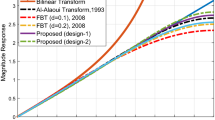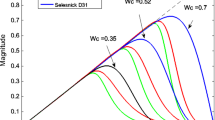Abstract
This work presents a new design method for nth-order infinite impulse response (IIR) differentiators. First, the cost function of the IIR differentiator is derived in closed form without frequency sampling. Next, a new optimization scheme is proposed to minimize the cost function under the pole radius constraint. Here, the magnitude and phase specifications are approximated simultaneously with a stability margin. Furthermore, discrete optimization for the IIR differentiator is presented for a specified word length constraint. The discrete optimization results in a stable IIR differentiator with finite word length coefficients owing to the stability margin. Finally, several design examples are demonstrated to evaluate the efficiency of the proposed method.
















Similar content being viewed by others
References
J. Ababneh, M. Khodier, Design of approximately linear phase low pass IIR digital differentiator using differential evolution optimization algorithm. Circuits Syst. Signal Process. 40(10), 5054–5076 (2021). https://doi.org/10.1007/s00034-021-01710-z
M. Al-Alaoui, Linear phase low-pass IIR digital differentiators. IEEE Trans. Signal Process. 55(2), 697–706 (2007). https://doi.org/10.1109/TSP.2006.885741
T. Baran, D. Wei, A.V. Oppenheim, Linear programming algorithms for sparse filter design. IEEE Trans. Signal Process. 58(3), 1605–1617 (2010). https://doi.org/10.1109/TSP.2009.2036471
W. Chen, M. Saif, Output feedback controller design for a class of MIMO nonlinear systems using high-order sliding-mode differentiators with application to a laboratory 3-D crane. IEEE Trans. Ind. Electron. 55(11), 3985–3997 (2008). https://doi.org/10.1109/TIE.2008.2004384
A. Chottera, G. Jullien, A linear programming approach to recursive digital filter design with linear phase. IEEE Trans. Circuits Syst. CAS–29(3), 139–149 (1982). https://doi.org/10.1109/TCS.1982.1085123
O.P. Goswami, T.K. Rawat, D.K. Upadhyay, A novel approach for the design of optimum IIR differentiators using fractional interpolation. Circuits Syst. Signal Process. 39(3), 1688–1698 (2020). https://doi.org/10.1007/s00034-019-01211-0
A. Gupta, S. Kumar, Closed-form analytical formulation for Riemann–Liouville-based fractional-order digital differentiator using fractional sample delay interpolation. Circuits Syst. Signal Process. 40(5), 2535–2563 (2021). https://doi.org/10.1007/s00034-020-01589-2
T. Hinamoto, W.-S. Lu, Digital Filter Design and Realization (River Publishers, 2017)
V.K. Ingle, J.G. Proakis, Digital Signal Processing Using Matlab (Cengage Learning, 2011)
M. Iqbal, A.I. Bhatti, S.I. Ayubi, Q. Khan, Robust parameter estimation of nonlinear systems using sliding-mode differentiator observer. IEEE Trans. Ind. Electron. 58(2), 680–689 (2011). https://doi.org/10.1109/TIE.2010.2046608
R. Kunii, T. Yoshida, N. Aikawa, Design method for low-delay maximally flat fir digital differentiators with variable stopbands obtained by minimizing \(L_p\) norm. IEICE Trans. Fundam. E100–A(7), 1713–1721 (2017). https://doi.org/10.1587/transfun.E100.A.1513
C. Mullis, R. Roberts, The use of second-order information in the approximation of discrete-time linear systems. IEEE Trans. Acoust. Speech Signal Process. ASSP–24(3), 226–238 (1976). https://doi.org/10.1109/TASSP.1976.1162795
M. Nakamoto, N. Aikawa, Minimax design of sparse IIR filters using sparse linear programming. IEICE Trans. Fundam. E104–A(8), 1006–1018 (2021). https://doi.org/10.1587/transfun.2020EAP1096
M. Nakamoto, T. Hinamoto, S. Ohno, Noise reduction in two-dimensional recursive digital filters with discrete optimized error feedback coefficients. Circuits Syst. Signal Process. 31(4), 1359–1378 (2012). https://doi.org/10.1007/s00034-011-9376-8
M. Nakamoto, S. Ohno, Design of multi-band digital filters and full-band digital differentiators without frequency sampling and iterative optimization. IEEE Trans. Ind. Electron. 61(9), 4857–4866 (2014). https://doi.org/10.1109/TIE.2013.2290765
R.C. Nongpiur, D.J. Shpak, A. Antoniou, Design of IIR digital differentiators using constrained optimization. IEEE Trans. Signal Process. 62(7), 1729–1739 (2014). https://doi.org/10.1109/TSP.2014.2302733
A.V. Oppenheim, R.W. Schafer, Discrete-Time Signal Processing (Prentice Hall, 2009)
Z.U. Sheikh, H. Johansson, A class of wide-band linear-phase fir differentiators using a two-rate approach and the frequency-response masking technique. IEEE Trans. Circuits Syst. I 58(8), 1827–1839 (2011). https://doi.org/10.1109/TCSI.2011.2107270
T. Stepinski, S. Banka, The differentiator of slowly varying electrical signals. IEEE Trans. Ind. Electron. Cont. Inst. IECI–22(1), 62–65 (1975). https://doi.org/10.1109/TIECI.1975.351222
S. Valiviita, S.J. Ovaska, Delayless recursive differentiator with efficient noise attenuation for motion control applications, in Proceedings of IEEE Annual Conference of the Industrial Electronics Society (1998), pp. 1481–1486. https://doi.org/10.1109/IECON.1998.722870
Y. Wang, New window functions for the design of narrowband lowpass differentiators. Circuits Syst. Signal Process. 32(4), 1771–1790 (2013). https://doi.org/10.1007/s00034-012-9536-5
T. Yoshida, Y. Sugiura, N. Aikawa, A closed-form design of linear phase fir band-pass maximally flat digital differentiators with an arbitrary center frequency. IEICE Trans. Fundam. E97–A(12), 2611–2617 (2014). https://doi.org/10.1587/transfun.e97.a.2611
T. Yoshida, Y. Sugiura, N. Aikawa, A general expression of the low-pass maximally flat fir digital differentiators, in Proceedings of IEEE International Symposium on Circuits and Systems (2015). https://doi.org/10.1109/ISCAS.2015.7169117
Acknowledgements
The authors would like to express sincere thanks to the anonymous reviewers for their valuable comments. This work was supported in part by the research grant from the Mazda Foundation.
Author information
Authors and Affiliations
Corresponding author
Additional information
Publisher's Note
Springer Nature remains neutral with regard to jurisdictional claims in published maps and institutional affiliations.
Rights and permissions
Springer Nature or its licensor (e.g. a society or other partner) holds exclusive rights to this article under a publishing agreement with the author(s) or other rightsholder(s); author self-archiving of the accepted manuscript version of this article is solely governed by the terms of such publishing agreement and applicable law.
About this article
Cite this article
Nakamoto, M., Aikawa, N. Closed Form Approach for Constrained Design of nth-Order IIR Digital Differentiator. Circuits Syst Signal Process 42, 3385–3411 (2023). https://doi.org/10.1007/s00034-022-02264-4
Received:
Revised:
Accepted:
Published:
Issue Date:
DOI: https://doi.org/10.1007/s00034-022-02264-4




